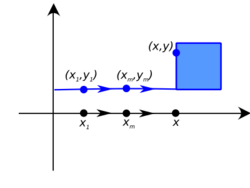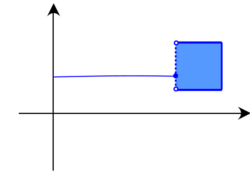Hemicontinuity
In mathematics, the notion of the continuity of functions is not immediately extensible to set-valued functions between two sets A and B. The dual concepts of upper hemicontinuity and lower hemicontinuity facilitate such an extension. A set-valued function that has both properties is said to be continuous in an analogy to the property of the same name for single-valued functions.
To explain both notions, consider a sequence a of points in a domain, and a sequence b of points in the range. We say that b corresponds to a if each point in b is contained in the image of the corresponding point in a.
- Upper hemicontinuity requires that, for any convergent sequence a in a domain, and for any convergent sequence b that corresponds to a, the image of the limit of a contains the limit of b.
- Lower hemicontinuity requires that, for any convergent sequence a in a domain, and for any point x in the image of the limit of a, there exists a sequence b that corresponds to a subsequence of a, that converges to x.
Examples


The image on the right shows a function that is not lower hemicontinuous at x. To see this, let a be a sequence that converges to x from the left. The image of x is a vertical line that contains some point (x,y). But every sequence b that corresponds to a is contained in the bottom horizontal line, so it cannot converge to y. In contrast, the function is upper hemicontinuous everywhere. For example, considering any sequence a that converges to x from the left or from the right, and any corresponding sequence b, the limit of b is contained in the vertical line that is the image of the limit of a.
The image on the left shows a function that is not upper hemicontinuous at x. To see this, let a be a sequence that converges to x from the right. The image of a contains vertical lines, so there exists a corresponding sequence b in which all elements are bounded away from f(x). The image of the limit of a contains a single point f(x), so it does not contain the limit of b. In contrast, that function is lower hemicontinuous everywhere. For example, for any sequence a that converges to x, from the left or from the right, f(x) contains a single point, and there exists a corresponding sequence b that converges to f(x).
Formal definition: upper hemicontinuity
A set-valued function is said to be upper hemicontinuous at the point if, for any open with , there exists a neighbourhood of such that for all is a subset of
Sequential characterization
For a set-valued function with closed values, if is upper hemicontinuous at then for all sequences in and all sequences such that
- if and then
As an example, look at the image at the right, and consider sequence a in the domain that converges to x (either from the left or from the right). Then, any sequence b that satisfies the requirements converges to some point in f(x). Therefore, the
If B is compact, the converse is also true.
Closed graph theorem
The graph of a set-valued function is the set defined by
If is an upper hemicontinuous set-valued function with closed domain (that is, the set of points where is not the empty set is closed) and closed values (i.e. is closed for all ), then is closed. If is compact, then the converse is also true.[1]
Formal definition: lower hemicontinuity
A set-valued function is said to be lower hemicontinuous at the point if for any open set intersecting there exists a neighbourhood of such that intersects for all (Here intersects means nonempty intersection ).
Sequential characterization
is lower hemicontinuous at if and only if for every sequence in such that in and all there exists a subsequence of and also a sequence such that and for every
Open graph theorem
A set-valued function have open lower sections if the set is open in for every If values are all open sets in then is said to have open upper sections.
If has an open graph then has open upper and lower sections and if has open lower sections then it is lower hemicontinuous.[2]
The open graph theorem says that if is a set-valued function with convex values and open upper sections, then has an open graph in if and only if is lower hemicontinuous.[2]
Properties
Set-theoretic, algebraic and topological operations on set-valued functions (like union, composition, sum, convex hull, closure) usually preserve the type of continuity. But this should be taken with appropriate care since, for example, there exists a pair of lower hemicontinuous set-valued functions whose intersection is not lower hemicontinuous. This can be fixed upon strengthening continuity properties: if one of those lower hemicontinuous multifunctions has open graph then their intersection is again lower hemicontinuous.
Crucial to set-valued analysis (in view of applications) are the investigation of single-valued selections and approximations to set-valued functions. Typically lower hemicontinuous set-valued functions admit single-valued selections (Michael selection theorem, Bressan–Colombo directionally continuous selection theorem, Fryszkowski decomposable map selection). Likewise, upper hemicontinuous maps admit approximations (e.g. Ancel–Granas–Górniewicz–Kryszewski theorem).
Implications for continuity
If a set-valued function is both upper hemicontinuous and lower hemicontinuous, it is said to be continuous. A continuous function is in all cases both upper and lower hemicontinuous.
Other concepts of continuity
The upper and lower hemicontinuity might be viewed as usual continuity:
- is lower [resp. upper] hemicontinuous if and only if the mapping is continuous where the hyperspace P(B) has been endowed with the lower [resp. upper] Vietoris topology.
(For the notion of hyperspace compare also power set and function space).
Using lower and upper Hausdorff uniformity we can also define the so-called upper and lower semicontinuous maps in the sense of Hausdorff (also known as metrically lower / upper semicontinuous maps).
See also
- Differential inclusion
- Hausdorff distance – Distance between two metric-space subsets
Notes
- ↑ Proposition 1.4.8 of Aubin, Jean-Pierre; Frankowska, Hélène (1990). Set-Valued Analysis. Basel: Birkhäuser. ISBN 3-7643-3478-9. https://books.google.com/books?id=cVUl3smcGlcC.
- ↑ 2.0 2.1 Zhou, J.X. (August 1995). "On the Existence of Equilibrium for Abstract Economies". Journal of Mathematical Analysis and Applications 193 (3): 839–858. doi:10.1006/jmaa.1995.1271.
References
- Template:Aliprantis Border Infinite Dimensional Analysis A Hitchhiker's Guide Third Edition
- Aubin, Jean-Pierre; Cellina, Arrigo (1984). Differential Inclusions: Set-Valued Maps and Viability Theory. Grundl. der Math. Wiss.. 264. Berlin: Springer. ISBN 0-387-13105-1. https://books.google.com/books?id=rVnsCAAAQBAJ.
- Aubin, Jean-Pierre; Frankowska, Hélène (1990). Set-Valued Analysis. Basel: Birkhäuser. ISBN 3-7643-3478-9. https://books.google.com/books?id=cVUl3smcGlcC.
- Deimling, Klaus (1992). Multivalued Differential Equations. Walter de Gruyter. ISBN 3-11-013212-5. https://books.google.com/books?id=ejhT-QMEVZ0C.
- Mas-Colell, Andreu; Whinston, Michael D.; Green, Jerry R. (1995). Microeconomic Analysis. New York: Oxford University Press. pp. 949–951. ISBN 0-19-507340-1. https://books.google.com/books?id=KGtegVXqD8wC&pg=PA949.
- Ok, Efe A. (2007). Real Analysis with Economic Applications. Princeton University Press. pp. 216–226. ISBN 978-0-691-11768-3.
 |
